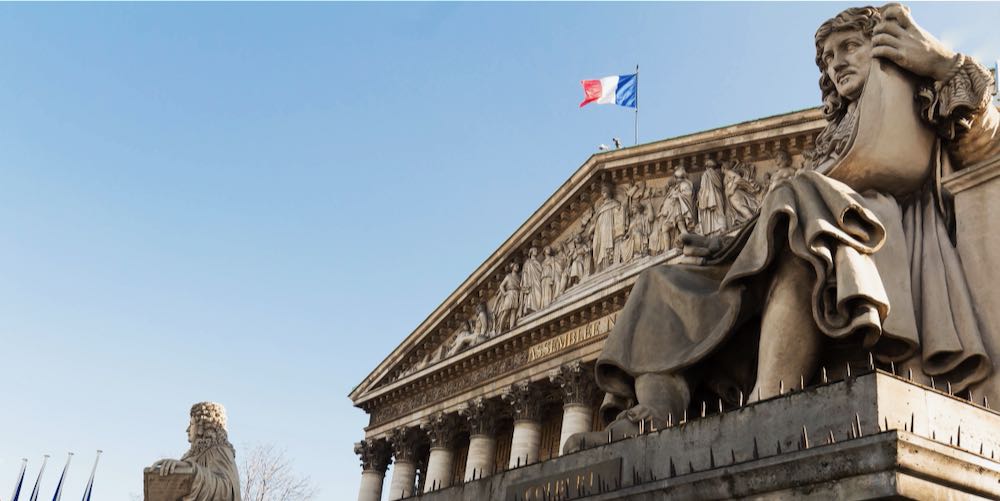Idealizing the English Constitution
It is commonly believed that French constitutional thought has continuously supported and enforced rationalism, political voluntarism, and written law. This is a distorting vision of the past. Indeed, French legal thinkers have invented, after the French National Revolution of 1789 and especially during the nineteenth century, an institutional model based on unwritten law and historical tradition. In parallel, this model is centered on a dualistic vision of parliamentarianism. It is still effective today, even though it has to face the progressive rise of the American influence in France, which has been strengthened by the election of the French President by direct universal suffrage since 1962. The story of this English constitutional model, as made by French legal theory, reveals a lot more about what these French legal thinkers wanted to create politically and institutionally, than about the reality of English parliamentarianism’s evolution during the nineteenth century.
To encapsulate this idea, a short quotation taken from Benjamin Disraeli’s Vindication of the English Constitution is relevant. In this excerpt, Disraeli refers to French political thinkers of the 1814 monarchic restoration: “Wearied with fruitless efforts, and exhausted by long suffering, they at length took refuge in the forced shade of exotic institutions.” These exotic institutions are, of course, the English ones.
After 1815 and the fall of Napoleon, one word became predominant in French political literature, formulating a deep desire: stability. The quotation of Disraeli is interesting because it underlines this quest for stability that would lead the French political and legal thinkers to become fascinated by the English Constitution. It also implies that these thinkers did not properly understand the English institutions of their time, because they created a representation that would fit their purpose. Indeed, it was impossible for them to understand the English system deeply as they were polarized in their own efforts to create the conditions of stability. Furthermore, the English institutions were very unsettled at this period because they did not adhere to principles or fixed rules.
French legal thinkers from 1814 to the first years of the Third Republic created an English institutional model of political prudence. This model sharpened the vision of English political culture as a conservative one. And it is quite interesting to notice that nowadays, conservatism has fallen into oblivion in France. Back then, French conservatism relied upon the wisdom of the historical English institutions, with their reputation for being constantly stable and modulable. This conservative vision of English institutions, which has to be combined with a specific understanding of liberty, has been strongly conveyed by a group of thinkers who were intellectually influential: the Doctrinaires. They were the main actors of what Victor Hugo called “libéralisme conservateur.” Led by François Guizot, these thinkers used the English Constitution as a template in order to legitimate their ideology which finally succeeded in the 1870s, taking the form of a republican dualistic parliamentarianism that mixed the traditional institutions of monarchy with the principle of social democracy.
From the mid-eighteenth century, the English Constitution and its French representation remained mismatched. Indeed, Montesquieu, in his famous book De l’esprit des lois, established a strong principle that would be admitted as a rule concerning the English Constitution. This English Constitution was supposed to be founded on a balance of powers, in which the executive and legislative branches were able to decide and to obstruct, restraining one another, either by the royal veto or by refusing to vote in favor of executive subsidies. In Montesquieu’s mind, the King remains superior insofar as he is able to participate in the legislative function, in particular with his veto. The judicial power is a void power. Its purpose is only to enforce legislative acts, without any scope of interpretation. This vision of the English Constitution tends to restore the ideal of the antique mixed Constitution. Montesquieu was a member of the aristocracy of lawyers, and he wanted the power of the King to be tempered by the knowledge and control of old parliaments.
French Doctrinaires such as Royer-Collard and Guizot saw through the morphology of the English civilization a society that secures liberty within order.
Importantly, this vision is mechanical, as Montesquieu seems to understand the institutional interactions in England as a clock-like device. Montesquieu’s description of English institutions had a massive impact on French constitutional ideas and remained predominant till the 1820s. What is really fascinating is that this description makes little sense, at least if one wishes to understand English historical institutions and their evolution during the eighteenth century. The real English Constitution seems to be missing in Montesquieu’s chapter on the English Constitution. He fails to discuss its historical foundation, and never gives a clear sense of the appearance of the English representative regime. As a result, the English Constitution is portrayed as a balance of powers designed to prevent the abuse of authority, and thus to protect liberty. It is thus the birth of the theoretical and liberal myth of the English Constitution.
The revolutionary French period created two main interpretations of the English Constitution that were poles apart. On the one hand, and to make things simple, the left-wing thinkers of the period, especially Rousseau and Sieyès, condemned English electoral corruption and bicameralism as an instrument allowing the creation of a refuge for noblemen in the House of Lords. On the other hand, the center-right, more precisely the Monarchiens and the Swiss lawyer Jean-Louis Delolme, defended a specific interpretation of the English king’s authority, combined with a tribute to Montesquieu’s work. To Delolme, the power of the king is a source of liberty, as its strength leads to contestations and eases the development of philosophical liberalism. More specifically, a few intellectuals of that period made visionary speeches in the French National Assembly, showing real foresight into what would become the parliamentary regime. Indeed, Mirabeau and Barnave were probably the first French legal thinkers to isolate political accountability from criminal accountability. Mirabeau clearly underlined the necessity for the king to appoint ministers in his cabinet who are members of the parliamentary majority and who are supported by public opinion.
In 1791, Jacques Necker showed himself hostile to a French unicameral Constitution. He drew the future model of the English Constitution in which the King is the main power, who is able to choose in the parliamentary majority his ministers, and master the dissolution of the representative chamber. Necker encouraged bicameralism. He admitted that the King can use the instrument of electoral corruption in order to influence the composition of the elective chamber. Against the revolutionaries’ abstract principles, Necker proposed a theory of constitutional prudence where the powers are united, anticipating the fusion of powers celebrated by Bagehot in the middle of the 19th century. Powers are united in order to be limited, allowing an aristocratic power to be realized. This was the combination of liberty and order that would be projected on the English during the nineteenth century.
After this intellectual effervescence during the revolutionary period, the English Constitution disappeared into oblivion. The fall of the French empire in 1815 resuscitated the myth of the liberal and conservative English Constitution. Two interpretations of the English Constitution, in the French political literature, faced each other. On the one hand, romantic liberals identified in its institutions the necessary elements to protect individuals from abuses of power and to allow the development of democracy. In the context of the historicist visions of law and institutions, Germaine de Staël and Benjamin Constant sacralized the English Constitution as the product of the wisdom of the ages. More especially, they tended to connect the English Constitution to an English tradition and civilization that was oriented towards liberty, knowing that this liberty, anticipating Tocqueville’s vision, was based on representative monarchy, aristocratic power, and progressive equality among people, on a social level.
What is interesting in De Staël and Constant’s interpretations, is that they invented the narrative of political stability in England, being influenced by Edmund Burke’s historical and customary vision of the English Constitution, even though they pretended to reject his thought. They conveyed the idea that English political institutions were stable and directed toward the achievement of liberty. For them, this movement had been reinforced by the Glorious Revolution of 1688, which was not conceived as a tabula rasa, but rather as a restoration of the peaceful, ordered liberty of monarchy. Benjamin Constant had a specific interpretation of the English Constitution that led him to construct a very subtle theory of representative government. In short, and besides this mythical and liberal view of the English Constitution, he created a theory that relied on the king’s neutral power, which refers to the dissolution of the representative assembly and on his personal unaccountability. This neutral power depended in part on the king’s majesty, as traditionally understood, which was supposed to be a source of moderation. As for the ministers, they were held accountable, but not in political terms. Still, they had to take into account the wishes of the parliamentary majority which reflected the new political source of legitimacy: public opinion.
On the other hand, traditionalists perceived in England’s historical continuity the structuring benefits of social hierarchy and aristocratic liberty. The monarchic and historical constitution of England was sometimes invoked by traditionalists looking to convince others that a written Constitution, expressing a human will to protect fundamental rights, was an illusion and an attempt to go against God’s unreachable purpose. This is why they celebrated the English Constitution as an example of an unwritten and providential Constitution, providence being an historical and aristocratic order in their minds.
More particularly, French Doctrinaires such as Royer-Collard and Guizot saw through the morphology of the English civilization a society that secures liberty within order. The Doctrinaires wrote many books focused on the history of England, from the Glorious Revolution. This historical approach to the English Constitution idealized English political culture. It is a socio-political scope that helped Guizot to build a reformist model, which is fundamentally conservative, meant to reconcile the Revolution’s liberty and monarchic tradition. Changes have to pass the test of customary legitimacy: no revolution is allowed, and only prudential evolution can be considered. As for Thiers, the French 1830 Revolution is the reproduction of the Glorious Revolution. It is not a revolution but a moment of reconciliation between monarchy, grounded in national sovereignty and not divine law, creating a liberal society directed towards free markets. In the end, the French Doctrinaires succeeded in spreading the vision of an aristocratic England, revealing a civilization aware of its particularities and interested in the vitality and conservation of a hierarchical society, tolerating the slow change of its composition.
As a synthesis of French yearnings for political stability, this representation historicizes the liberal achievement of representative government and endorses the legitimacy of innovation through custom. French thinkers recognized in parliamentariansm, as a product of England’s institutional evolution, the political regime capable of putting an end to French revolutionary tensions.
As a result of this construction of the English constitutional and historical model, the legal aspect of the English Constitution was largely overlooked. The English Constitution had to be an institutional arrangement allowing the conservation of the French post-revolutionary, upper-middle class society. Back then, there were very few writings on English radicalism or on socialism. To top it all, the 1832 Reform Bill was not mentioned in the writings of the Doctrinaires. In some ways, its pre-democratic dimension had to be ignored.
Simultaneously, an institutional theory of parliamentary regime appeared. It relied on a specific setting of powers, given an interpretation of the English institutions. It was a system of mutual vetoes in which the king was permitted to dissolve the representative chamber, while the chamber could provoke the ministerial cabinet’s resignation because of a political disagreement, the ministers being appointed by the king. It was a dualistic vision that remained mechanical, even though it was predominantly intended as a mold to regulate social and political evolution.
Despite the republican episode between 1848 and 1851, and the rebirth of the empire from 1852 through its liberalization, the monarchic and dualistic vision of parliamentarianism was reinforced before its paradoxical consecration with the French Third Republic. Indeed, a specific literature started a doctrinal policy in the late 1850s. The purpose was to convince the public that this parliamentarianism would embody the virtue of moderation. One fundamental book was La France Nouvelle, written by Prévost-Paradol in 1868, and it delivered a sort of program that set the principles of French parliamentarism’s ideal based on the English model, and on a theoretical interpretation of the July Monarchy (1830-1848).
As a mold that both liberates the energies of individuals and protects the political and social order, a parliamentary regime renders the Head of State personally unaccountable. It empowers public opinion through the superiority of the elected chamber and the demand for government accountability. Finally, it disciplines political action through the historical practices inherited from representative monarchy.
The laconism of the constitutional laws of the Third Republic reflects a constitutional reformism. Rather than a circumstantial political compromise, it crystallizes a liberal and conservative constitutional policy, which is the consequence of a sort of acculturation of the English Constitution.
This model of the parliamentary regime, in its monarchic dimension, will have to slow radical impulses down. It is also meant to educate the nation through the aristocratic dynamic of election. This desired parliamentarianism, which remains linked to the dualistic form and the predominant king’s influence, has to temper democratic yearnings. It will be able to do so thanks to its prudential legal and institutional mechanisms, among which we find a higher chamber composed of indirect representatives chosen by a territorial criteria that support rural areas. The representatives themselves will come from the local bourgeoisie, which is supposedly determined to find a fair balance between improvement and conservation. Besides, the head of the state, whether he is a king or a president of the Republic, has to embody this neutral power to appease or to arbitrate the potential conflicts between the ministerial cabinet and the representative chamber.
Based on a political project, parliamentary government in France gives substance to a prudential philosophy of constitutional law. This philosophy views the constitution as an institutional framework within which political action must be able to adapt society to its historical phase of development. The laconism of the constitutional laws of the Third Republic reflects this constitutional reformism. Rather than a circumstantial political compromise, it crystallizes a liberal and conservative constitutional policy, which is the consequence of a sort of acculturation of the English Constitution. In other words, the construction of the model was completed, and it was rooted in the French political and legal culture.
The story of the French understanding of the English Constitution is actually the story of a continuous mismatch. One key problem is that the French find it very difficult to conceive of political accountability. It can be argued that French legal thinkers did not fully understand political accountability until the late 1830s. If we put aside one or two texts, ministerial responsibility remained lately perceived in its criminal dimension, and in a specific moral way. Indeed, the major thinkers of this period did not disconnect ministerial responsibility from the king’s choice, and from the sense of honor that would compel the ministers to appropriate action with regard to the king’s political wishes. Ministers were responsible for the morality of their actions, and they would resign if they did not appear gracious enough to public opinion and to the king. As a consequence, political accountability was not understood for what it was in England since the early nineteenth century. It was, back then, a constructive responsibility that would bind the ministerial cabinet and the parliamentary regime with the partisan link, the common belonging of the ministers and the majority to a political party. There was a programmatic dynamic to English parliamentarianism. The conflict could only arise if the government did not respect the political program that the majority was supposed to sustain. This device could not work in France until the late nineteenth century because there were no political parties, as the king or the emperor would not allow their proper growth.
This parliamentarian model has remained influential in the twentieth century. It was still an institutional guiding principle until the first years of the Fifth Republic, which was adopted in 1958. The present French Constitution has built a specific rationalized parliamentary regime that is combined with the referendum and constitutional supremacy on bills, particularly thanks to constitutionality review. Nevertheless, there is still a strange denial of this analysis, which has been probably reinforced by the 1962 revolution of the presidential election by direct universal suffrage. It became all the more obvious in the 1970s, which was a period of fascination with the American model. This culminated quite recently in 2008 with a constitutional reform introducing the exception of unconstitutionality, the reinforcement of parliamentary committees and the control of presidential appointments. This reform has not weakened the presidential hold on the French political and institutional system, because of the majority rule that clearly benefits the President. A lot of observers tend to forget that the parliamentary regime was born on acceptable corruption in England, as we see in David Hume’s writings. There is a form of bargaining in the election process. Still, it has to respect some sort of morality. Furthermore, the parliamentary regime historically relies on aristocratism.
This fascination with the American model is perhaps an escape in order to avoid admitting that our French Republic still hides a powerful elective monarchy, whose theory was built thanks to the English constitutional model of the nineteenth century.



